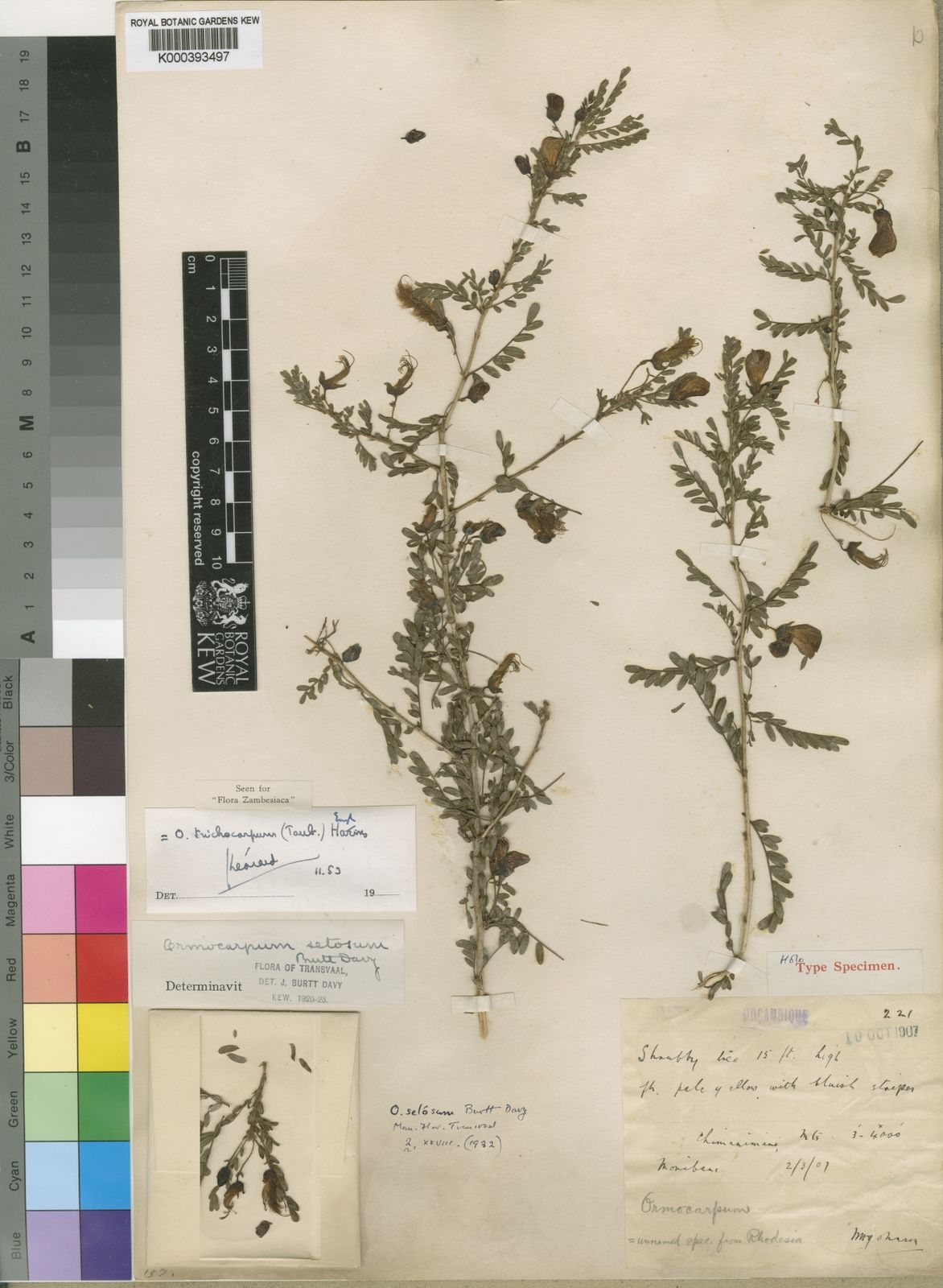unknown
ormocarpum trichocarpum
Also known as: []
Overview
A species of flowering plant in the family Fabaceae, native to tropical regions.
Benefits & Perks
["wildlife attractant (bees, butterflies, birds)"]
Botanical Classification
| Phylum: | Magnoliophyta |
| Class: | Magnoliopsida |
| Order: | Fabales |
| Family: | Fabaceae |
| Genus: | Ormocarpum |
| Botanical Name: | Ormocarpum trichocarpum |
Plant Characteristics
Basic Information
- Category: Flowers
- Suitable Location: outdoor garden bed in warm, sheltered area
- Suitable For:
- Is Weed: No
- Allergenicity: unknown
Environmental Needs
- Climate: {"temperatureRange":"15–35°C"}
- Hardiness: {"zones":"9–11"}
- Misting: rarely required, only if ambient humidity is very low
- Drainage: Fast-draining to prevent waterlogging.
- Soil Type: Well-draining, loamy soil with organic matter.
Maintenance Level
- Maintenance Level: unknown
- Toughness Level: unknown
- Pruning Frequency: Annually or as needed to maintain shape.
- Pruning Intensity: Moderate; remove up to one-third of growth if overgrown.
Care Details
Ideal Sunlight Coverage:
Full sun (6–8 hours/day); tolerates partial shade in intense heat.
Sunlight Tolerance Tips:
Acclimate gradually to intense sunlight; protect from harsh afternoon sun; adjust placement based on seasonal light changes.
Care Requirements
Care Difficulty
unknownmoderate
Sunlight
full sun to partial shade
Morning sun is ideal; rotate plant for even growth; avoid direct midday sun in summer.
Watering
every 7–10 days during active growth, reduce in winter
Water thoroughly but infrequently; ensure proper drainage; adjust based on season and growth stage.
Soil
well-draining, sandy loam with moderate organic content
pH: Slightly acidic to neutral (pH 6.0–7.0).
Ensure good drainage; avoid heavy clay; enrich with organic matter.
Temperature
Warm temperatures (20–30°C); sensitive to frost; prefers stable conditions.
Protect from frost; avoid sudden temperature swings; maintain warmth in winter.
Fertilizing
every 4–6 weeks during growing season
Fertilize during active growth; dilute to prevent burn; stop in dormant periods.
Propagation
Methods
Stem cuttings or seeds.
Step-by-Step Propagation Guide
- Take cutting.
- Apply hormone.
- Plant in medium.
- Maintain humidity.
- Wait for roots.
Best Time: Spring or early summer when the plant is actively growing.
Environment
Warm, humid, and bright indirect light.
Medium
Well-draining mix of perlite and peat moss.
Hormone
Rooting hormone recommended for faster rooting.
Timeline
Roots in 3–6 weeks; establish in 2–3 months.
Tools Needed
Pruners, rooting hormone, small pots, misting spray bottle.
Quick Tips
Use healthy stems; keep consistently moist; provide warmth for rooting.
Pruning & Repotting
Pruning Guide
Method
Selective cutting of stems; pinch back tips for bushiness.
Pruning Plan
Shape plant, remove dead/damaged growth, encourage bushier form.
Tools
Pruning shears, sterilizing solution, gloves.
Checklist
Sterilize tools; prune dead/damaged growth; shape evenly; clean up debris.
Repotting Guide
Best Season
Spring before active growth begins.
Pot Size
One size larger pot; ensure drainage holes.
Method
Remove plant gently; trim roots if needed; repot in fresh soil with good drainage.
Suggestions
Repot every 2–3 years or when roots fill the pot; promotes growth.
Checklist
Check root bound status; prepare new pot; use fresh soil; water lightly after repotting.
Advanced Care Tips
Watering Mastery
Watering Checklist
Check soil moisture; water deeply; ensure drainage; adjust for season.
How to Apply Water Properly
Water at the base of the plant, ensuring moisture reaches the root zone; avoid wetting foliage; allow excess water to drain away.
Watering Schedule Tips
Water deeply once the top inch of soil feels dry; reduce frequency in winter to prevent root rot.
Soil Improvement
Add perlite or sand for drainage; incorporate compost for fertility.
Temperature Stress Management
Signs of Temperature Issues
Wilting, leaf drop, or stunted growth in extreme heat or cold.
Cold Stress
Growth cessation, leaf damage, or death in temperatures below 10°C.
Solution: Move to a warmer location; provide frost protection; avoid overwatering in cold.
Hot Stress
Leaf scorch, wilting, or reduced flowering in excessive heat.
Solution: Provide shade during peak heat; increase humidity; water more frequently.
Fertilizing Guide
Fertilizing Checklist
Check growth stage; use diluted fertilizer; avoid winter feeding.
Fertilizing Method
Use balanced liquid fertilizer diluted to half strength every 4–6 weeks during growing season; avoid fertilizing in winter.
Common Problems & Solutions
Toxicity Warning
Cats
ToxicOrmocarpum trichocarpum is toxic to cats when ingested. The plant contains substances that can cause severe gastrointestinal and systemic effects, potentially leading to serious health complications.
⚠️ Symptoms:
🌿 Toxic Parts:
⚡ Toxic If:
if eaten
Dogs
ToxicIngestion of Ormocarpum trichocarpum by dogs can lead to significant toxicity due to the presence of harmful compounds. These toxins can disrupt normal bodily functions and cause severe health issues.
⚠️ Symptoms:
🌿 Toxic Parts:
⚡ Toxic If:
if eaten
Humans
ToxicOrmocarpum trichocarpum contains toxic compounds that can cause severe physiological effects upon ingestion. The toxins interfere with metabolic processes, leading to systemic toxicity.
⚠️ Symptoms:
🌿 Toxic Parts:
⚡ Toxic If:
if eaten
Frequently Asked Questions
Q: Is Ormocarpum trichocarpum toxic to pets?
A: Unknown, no specific studies are available.
Q: What are the common uses of Ormocarpum trichocarpum?
A: Unknown, limited information is available.
Q: How difficult is it to grow Ormocarpum trichocarpum?
A: Unknown, specific care requirements are not well documented.
Quick Reference
| Family: | Fabaceae |
| Care: | unknown |
| Light: | full sun to partial shade |
| Water: | every 7–10 days during activ |
Get Expert Care Tips
Download the Plantious app for personalized care reminders and plant identification!
Google Play App Store






